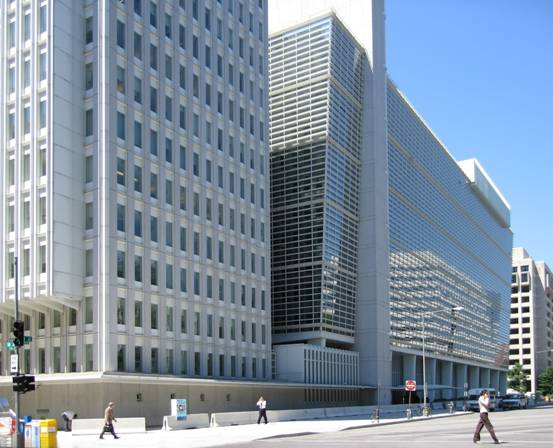Syllabus:
Examine the current roles of the IMF and the World Bank in promoting
economic development. (see previous page for IMF)
The World Bank

The World Bank building in Washington
The World Bank is not a bank, but rather a specialised agency.
The World Bank is not a "bank" in the common sense. It is one of the United Nations' specialised agencies, and is made up of 184 member countries. These countries are jointly responsible for how the institution is financed, and how its money is spent. Along with the rest of the development community, the World Bank centres its efforts on reaching the Millennium Development Goals, agreed to by UN members in 2000 and aimed at sustainable poverty reduction.
While the IMF was concerned with stabilising the international finance system through short term lending to those countries with balance of payments deficits, the World Bank's role was concerned with financing reconstruction and development through the construction of national infrastructure such as roads and dams. By supporting projects through funding, and providing technical assistance, the World Bank considered that it would bring about increases in productivity, output and incomes and self-sustaining economic growth.
The "World Bank" is the name that has come to be used for the International Bank for Reconstruction and Development (IBRD) and the International Development Association (IDA). Together these organizations provide low-interest loans, interest-free credit, and grants to developing countries as follows:
-
The International Bank for Reconstruction and Development (IBRD)
This IBRD lends money at commercial interest rates to governments or private firms, guaranteed by their governments. -
The International Development Association
The IDA lends money, called credits, to the poorest countries on concessionary terms i.e. the repayment periods are longer than the IBRD's loans and the loans are interest free. These are called 'soft loans'.
In addition, the International Finance Corporation (IFC) is closely affiliated to the World Bank. It was started up to enable funds to be lent to, or used to purchase shares in, private firms engaged in activities that would lead to development, but not needing a government guarantee.
Up until the 1970s, much World Bank lending was targeted at projects primarily concerned with building energy and transportation infrastructure in developing economies. Its early history had been concerned with similar projects in reconstructing war torn Europe. The poor economic performance and continued lack of development of many of the countries that had received World Bank assistance resulted in a rethink of the approach of the IBRD and the IDA. The new approach involved identifying specific needs of regions within developing countries, and invariably this meant targeting smaller scale development projects, often of a very diversified nature.
Many of these were concerned with funding agricultural projects, and usually those that stimulated the growth of cash crops. The intention was that such support would raise the incomes of smaller scale farmers and encourage food production. Projects aimed at the tourist industry, education, water supply and health care have also been supported.
Since the 1980s many World Bank loans have, like the IMF, been tied to certain strict conditions laid down in structural adjustment programmes.